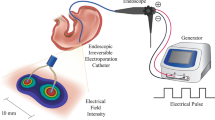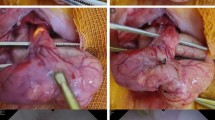Abstract
Introduction
According to the latest Japanese nationwide estimates, over a million Japanese people are newly diagnosed with cancer each year. Since gastrointestinal cancers account for more than 40% of all cancer-related deaths, it is imperative to formulate effective strategies to control them.
Materials and methods, and results
Basic drug discovery research Our research has revealed that the abnormal expression of regulators of chromosomal stability is a cause of cancers and identified an effective compound against cancers with chromosomal instability. We revealed the molecular mechanism of peritoneal dissemination of cancer cells via the CXCR4/CXCL12 axis to CAR-like cells and identified an MEK inhibitor effective against these tumors. Residual tumor cells after chemotherapy in colorectal cancer are LGR5-positive cancer stem cells and their ability to eliminate reactive oxygen species is elevated. The development of surgical procedures and devices In cases of gastric tube reconstruction for esophageal cancer, we determined the anastomotic line for evaluating the blood flow using ICG angiography and measuring the tissue O2 metabolism. We established a novel gastric reconstruction method (book-binding technique) for gastric cancer and a new rectal reconstruction method focusing on the intra-intestinal pressure resistance for rectal cancer. We established a novel tissue fusion method, which allows contact-free local heating and retains tissue viability with very little damage, and developed an understanding of the collagen-related processes that underpin laser-induced tissue fusion. Strategy to prevent carcinogenesis We succeeded in cleaving hepatitis B virus DNA integrated into the nucleus of hepatocytes using genome editing tools. The development of HCC from non-alcoholic steatohepatitis (NASH) may be prevented by metabolic surgery.
Conclusion
We believe that these efforts will help to significantly improve the gastrointestinal cancer treatment and survival.


















Similar content being viewed by others
References
Kasagi Y, Harada Y, Morodomi Y et al (2016) Peritoneal dissemination requires an Sp1-dependent CXCR1/CXCL12 signaling axis and extracellular matrix-directed spheroid formation. Cancer Res 76:347–357
Kobayashi S, Yamada-Okabe H, Suzuki M et al (2012) LGR5-positive colon cancer stem cells interconvert with drug-resistant LGR5-negative cells and are capable of tumor reconstitution. Stem Cells 30:2631–2644
Ando K, Kakeji Y, Kitao H et al (2010) High expression of BUBR1 is one of the factors for inducing DNA aneuploidy and progression in gastric cancer. Cancer Sci 101(3):639–645
Honma K, Nakanishi R, Nakanoko T et al (2014) Contribution of Aurora-A and -B expression to DNA aneuploidy in gastric cancers. Surg Today 44(3):454–461
Otsu H, Iimori M, Ando K et al (2016) Gastric cancer patients with high PLK1 expression and DNA aneuploidy correlate with poor prognosis. Oncology 91(1):31–40
Nishimura S, Oki E, Ando K et al (2017) High ubiquitin-specific protease 44 expression induces DNA aneuploidy and provides independent prognostic information in gastric cancer. Cancer Med 6(6):1453–1464
Iimori M, Watanabe S, Kiyonari S et al (2016) Phosphorylation of EB2 by Aurora B and CDK1 ensures mitotic progression and genome stability. Nat Commun 7:11117
Fujii S, Ikenaka K, Fukushima M et al (1978) Effect of uracil and its derivatives on antitumor activity of 5-fluorouracil and 1-(2-tetrahydrofuryl)-5-fluorouracil. GANN Jpn J Cancer Res 69(6):763–772
Shirasaka T, Nakano K, Takechi T et al (1996) Antitumor activity of 1 M tegafur-0.4 M 5-chloro-2,4-dihydroxypyridine-1 M potassium oxonate (S-1) against human colon carcinoma orthotopically implanted into nude rats. Cancer Res 56(11):2602–2606
Maehara Y, Kusumoto T, Kusumoto H et al (1989) 5-Fluorouracil and UFT-sensitive gastric carcinoma has a high level of thymidylate synthase. Cancer 63(9):1693–1696
Maehara Y, Takeuchi H, Oshiro T et al (1994) Effect of gastrectomy on the pharmacokinetics of tegafur, uracil, and 5-fluorouracil after oral administration of a 1:4 tegafur and uracil combination. Cancer Chemother Pharmacol 33(6):445–449
Maehara Y (2003) S-1 in gastric cancer: a comprehensive review. Gastric Cancer 6(Suppl 1):2–8
Oki E, Murata A, Yoshida K et al (2016) A randomized phase III trial comparing S-1 versus UFT as adjuvant chemotherapy for stage II/III rectal cancer (JFMC35-C1: ACTS-RC). Ann Oncol 27(7):1266–1272
Oki E, Tokunaga S, Emi Y et al (2016) Surgical treatment of liver metastasis of gastric cancer: a retrospective multicenter cohort study (KSCC1302). Gastric Cancer 19(3):968–976
Shinozaki K, Yuki S, Kashiwada T et al (2017) A phase II study (KSCC/HGCSG/ COG/PerSeUS1501B) of trastuzumab plus S-1 and oxaliplatin for HER2-positive advanced gastric cancer. ASCO 2017 (Abstract #4059)
Edahiro K, Iimori M, Kobunai T et al (2018) Thymidine kinase 1 loss confers trifluridine resistance without affecting 5-fluorouracil metabolism and cytotoxicity. Mol Cancer Res 16(10):1483–1490
Matsuoka K, Iimori M, Niimi S et al (2015) Trifluridine induces p53-dependent sustained G2 phase arrest with its massive misincorporation into DNA and few DNA strand breaks. Mol Cancer Ther 14(4):1004–1013
Kiyonari S, Iimori M, Matsuoka K et al (2015) The 1,2-diaminocyclohexane carrier ligand in oxaliplatin induces p53-dependent transcriptional repression of factors involved in thymidylate biosynthesis. Mol Cancer Ther 14(10):2332–2342
Shojaei F, Wu X, Ferrara N et al (2007) Tumor refractoriness to anti-VEGF treatment is mediated by CD11b+Gr1+ myeloid cells. Nat Biotechnol 25:911–920
Iwai T, Harada Y, Yonemitsu Y et al (2018) Capecitabine reverses tumor escape from anti-VEGF through the eliminating CD11bhigh/Gr1high myeloid cells. Oncotarget 9(25):17620–17630
Yamashita N, Tokunaga E, Iimori M et al (2018) Epithelial paradox: clinical significance of coexpression of E-cadherin and vimentin with regard to invasion and metastasis of breast cancer. Clin Breast Cancer 18(5):e1003–e1009
Yukaya T, Saeki H, Kasagi Y et al (2015) Indocyanine green fluorescence angiography for quantitative evaluation of gastric tube perfusion in patients undergoing esophagectomy. J Am Coll Surg 221:e37–e42
Nakashima Y, Saeki H, Yukaya T et al (2016) Blood flow assessment with indocyanine green fluorescence angiography for pedicled omental flap on cervical esophagogastric anastomosis after esophagectomy. J Am Coll Surg 222(5):e67–e69
Tsutsumi R, Ikeda T, Nagahara H et al (2019) Efficacy of novel multispectral imaging device to determine anastomosis for esophagogastromy. J Surg Res 242:11–22
Ikeda T, Kawano H, Hisamatsu Y et al (2013) Progression from laparoscopic-assisted to totally laparoscopic distal gastrectomy: comparison of circular stapler (i-DST) and linear stapler (BBT) for intracorporeal anastomosis. Surg Endosc 27(1):325–332
Oki E, Tsuda Y, Saeki H et al (2014) Book-binding technique for Billroth I anastomosis during totally laparoscopic distal gastrectomy. J Am Coll Surg 219:e69–e73
Ikeda T, Kumashiro R, Oki E et al (2015) Evaluation of techniques to prevent colorectal anastomotic leakage. J Surg Res 194(2):450–457
Ikeda T, Kumashiro R, Taketani K et al (2015) Endoscopic evaluation of clinical colorectal anastomotic leakage. J Surg Res 193(1):126–134
Storer E.H., Goldberg S.M., S. Nivatvongs Colon, rectum and anus (6rd ed.) Schwartz S.I., Shires G.T., Spencer F.C., Storer E.H. (Eds.), Principles of surgery, 26, McGraw-Hill, New York (1994), pp. 1191-1306.
Gevorkian SG, Allahverdyan AE, Gevorgyan DS et al (2013) Stabilization and anomalous hydration of collagen fibril under heating. PLoS One 8(11):e78526
Shuster S, Black MM, McVitie E (1975) The influence of age and sex on skin thickness, skin collagen and density. Br J Dermatol 93:639–643
Culav EM, Clark CH, Merrilees MJ (1999) Connective tissues: matrix composition and its relevance to physical therapy. Phys Ther 79:308–319
Sasaki S, Ikeda T, Okihara SI et al (2019) Principles and development of collagen-mediated tissue fusion induced by laser irradiation. Sci Rep 9(1):9383
Takamori S, Tagawa T, Toyokawa G et al (2018) The significant influence of having children on the postoperative prognosis of patients with nonsmall cell lung cancer: a propensity score-matched analysis. Cancer Med 7:2860
Williams H, Pembroke A (1989) Sniffer dogs in the melanoma clinic? Lancet 1(8640):8734
Willis CM, Church SM, Guest CM et al (2004) Olfactory detection of human bladder cancer by dogs: proof of principle study. BMJ 329(7468):712
Cornu JN, Cancel-Tassin G, Ondet V et al (2011) Olfactory detection of prostate cancer by dogs sniffing urine: a step forward in early diagnosis. Eur Urol 59(2):197–201
Ehmann R, Boedeker E, Friedrich U et al (2012) Canine scent detection in the diagnosis of lung cancer: revisiting a puzzling phenomenon. Eur Respir J 39(3):669–676
Sonoda H, Kohnoe S, Yamazato T et al (2011) Colorectal cancer screening with odour material by canine scent detection. Gut 60:814–819
Huang De, Li T, Li X et al (2014) HIF-1-mediated suppression of acyl-CoA dehydrogenases and fatty acid oxidation is critical for cancer progression. Cell Rep 8:1930–1942
Onkenhout W, Venizelos V, van der Poel PF et al (1995) Identification and quantification of intermediates of unsaturated fatty acid metabolism in plasma of patients with fatty acid oxidation disorders. Clin Chem 41(10):1467–1474
Takenaka K, Kawahara N, Yamamoto K et al (1996) Results of 280 liver resections for hepatocellular carcinoma. Arch Surg 131(1):71–76
Shirabe K, Takeishi K, Taketomi A et al (2011) Improvement of long-term outcomes in hepatitis C virus antibody-positive patients with hepatocellular carcinoma after hepatectomy in the modern era. World J Surg 35(5):1072–1084
Yoshizumi T, Ikegami T, Yoshiya S et al (2013) Impact of tumor size, number of tumors and neutrophil-to-lymphocyte ratio in liver transplantation for recurrent hepatocellular carcinoma. Hepatol Res 43(7):709–716
Harimoto N, Shirabe K, Ikegami T et al (2015) Postoperative complications are predictive of poor prognosis in hepatocellular carcinoma. J Surg Res 199(2):470–477
Itoh S, Morita K, Ueda S et al (2009) Long-term results of hepatic resection combined with intraoperative local ablation therapy for patients with multinodular hepatocellular carcinomas. Ann Surg Oncol 16(12):3299–3307
Ikeda T, Mano Y, Morita K et al (2013) Pure laparoscopic hepatectomy in semiprone position for right hepatic major resection. J Hepatobiliary Pancreat Sci 20:145–150
Sugimachi K, Shirabe K, Taketomi A et al (2010) Successful curative extra-corporeal hepatic resection for far-advanced hepatocellular carcinoma in an adolescent patient. Liver Transplant 16:685–687
Valsamakis A (2007) Molecular testing in the diagnosis and management of chronic hepatitis B. Clin Microbiol Rev 20:426–439
Kurihara T, Fukuhara T, Ono C et al (2017) Suppression of HBV replication by the expression of nickase- and nuclease dead-Cas9. Sci Rep 7:6122
Grothey A, Sobrero AF, Shields AF et al (2018) Duration of adjuvant chemotherapy for stage III colon cancer. N Engl J Med 378:1177–1188
Yoshino T, Yamanaka T, Oki E et al (2019) Efficacy and long-term peripheral sensory neuropathy for 3 versus 6 months of oxaliplatin-based adjuvant chemotherapy for stage III colon cancer: results of the randomised open-label, non-inferiority, Japanese phase 3 ACHIEVE trial, part of the IDEA study collaboration. JAMA Oncol
Acknowledgements
Twenty seven of our studies have been financially supported by these agencies. I received the grants as the representative of these studies. We would like to extend our sincere appreciation to the Ministry of Education, Culture, Sports, Science and Technology; the Ministry of Health, Labour and Welfare; and the Japan Agency for Medical Research and Development.
Author information
Authors and Affiliations
Corresponding author
Ethics declarations
Conflict of interest
We disclose the following conflicts of interest. We offer our heartfelt gratitude to the cooperation extended by the research institutes of these four companies: Taiho Pharmaceutical, Chugai Pharmaceutical, Ono Pharmaceutical, and Yakult Honsha.
Additional information
Publisher's Note
Springer Nature remains neutral with regard to jurisdictional claims in published maps and institutional affiliations.
About this article
Cite this article
Maehara, Y., Soejima, Y., Yoshizumi, T. et al. The evolution of surgical treatment for gastrointestinal cancers. Int J Clin Oncol 24, 1333–1349 (2019). https://doi.org/10.1007/s10147-019-01499-7
Received:
Accepted:
Published:
Issue Date:
DOI: https://doi.org/10.1007/s10147-019-01499-7




